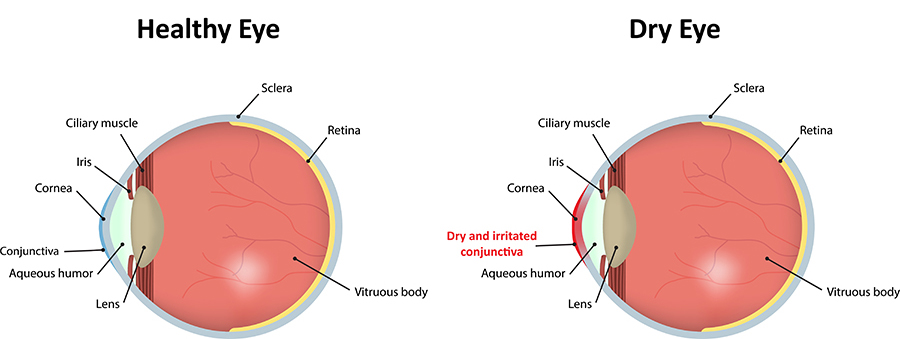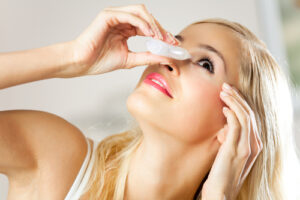Do your eyes feel dry, itchy, irritated, or tired? These are some signs of a chronic eye condition called dry eye syndrome.
Having dry eyes is common and treatable. At RGB Eye Associates, our team of ophthalmologists offers various treatments for dry eye and can help you find the one that works best for you.
What is Dry Eye?

Dry eye is a condition that occurs when your eyes aren’t producing enough tears, or the tears that you create are low in quality. Because there are not enough tears, it becomes difficult to keep a healthy film of tears covering your eyes.
The disruption in tears could result from your body making fewer tears than needed. It’s also possible that your tears are deficient in one of the layers required for having a healthy tear film.
Your tear film needs to have three layers: oily, water, and mucus. If any of these necessary components are missing or are lacking, it can result in experiencing dry eyes.
What are the Symptoms of Having Dry Eyes?
If you have dry eyes, your eyes may feel irritated and uncomfortable.
Other symptoms of dry eye that you may experience include:
• Your eyes sting, burn, or feel like there’s a foreign body in them even if there’s nothing there
• Your vision is blurry, making it more challenging to drive at night
• You start noticing stringy mucus around your eyes
• Your eyes become more sensitive to light
• Your eyes are more watery
• It starts becoming uncomfortable or impossible to wear contact lenses
• Your eyes feel tired or strained after spending time in front of digital devices
Experiencing dry eye symptoms may worsen over time if you don’t do anything about them.
What Causes Dry Eye?
Many factors can disrupt the production of healthy tears. Possible causes that can lead to having dry eyes include:
• Hormonal changes can lead to dry eyes if you’re taking medications like an oral contraceptive or going through menopause or pregnancy
• Medical conditions, including autoimmune diseases like Sjogren’s syndrome and lupus
• Medications like antihistamines, decongestants, blood pressure medicines, and antidepressants
• Getting older
• You have problems with the lacrimal glands that produce your tears
• You have meibomian gland dysfunction (MGD)
• Wearing contact lenses
What Can I Do to Prevent Dry Eyes?
If you know that your eyes can feel dry, it’s necessary to avoid situations that make them feel more uncomfortable. Next, consider steps you can take to improve these situations that commonly trigger dry eye:
Avoid Air Blowing Directly at You
Do your best to avoid being around any air or heat sources that blow directly at your face. Keep fans and hair dryers pointed away from your eyes or face.
Reducing the likelihood of this can make a big difference in how your eyes feel, especially during colder and drier winter months.
Combat Dry Indoor Air
Humidifiers are an excellent way to put much-needed moisture back in the air. Consider putting humidifiers in places you spend the most time, like your bedroom or your office where you work, to see the most significant impact. Use a humidifier to increase indoor humidity.
Take a Break to Help Your Eyes
If you’re focused intently on a task, you may not remember to blink as much as you should. Blinking is a critical job that ensures that your tears spread over your eyes, providing crucial moisture.
If you’ve been doing the same task for several hours, take a break by following the 20-20-20 rule. Every twenty minutes, stop what you’re doing to look at something that’s twenty feet away from you for at least twenty seconds. Use this time to blink and give your eyes a break.
Stop Smoking and Avoid Other Smokers
If you’re a smoker, surrounding yourself with cigarette smoke is not doing your eyes any favors. Being around secondhand smoke from smokers can irritate your eyes, making them feel dry, itchy, or generally uncomfortable.
Your eyes will start feeling much better once you’re no longer around smoke regularly.
Adjust Computer Monitors
When working on a computer, ensure that your screen is in the proper position. Your screen should be below eye level, preventing you from widening your eyes to read the screen. When your eyes are wide open, tears may evaporate more quickly.
Use Eye Drops and Artificial Tears Before Your Eyes Feel Dry

If you experience dry eye symptoms, you may already know that eye drops and artificial tears can be extremely helpful. But for the most relief, keep them on hand before your eyes start to bother you.
Using eye drops and artificial tears before your eyes are dry or scratchy can make a big difference. Keep them in your desk at work or in a bag on you to always have them when you need them.
Making these changes can help you experience fewer symptoms, but it can take a combination of lifestyle changes and medication for many patients before finding the relief they need.
Should I See an Eye Doctor for Dry Eye Treatment?
If you have persistent, long-term dry eye symptoms, schedule an appointment with RGB Eye Associates. One of our specialists can determine what’s causing your dry eye and discuss possible treatments with you.
Dry eyes are uncomfortable, and they can limit your daily activities. But it can also have more concerning complications, so it’s worth visiting your eye doctor for an exam.
With fewer tears, your eyes have less protection against infection, meaning your eyes may be more prone to eye infections. Eye inflammation, corneal ulcers, and abrasion of the corneal surface are possible. If left untreated, dry eyes could damage your vision.
How is Dry Eye Diagnosed?
Your eye doctor will perform a comprehensive eye exam and complete several tests to find what’s causing your dry eye. Tests can include:
• Measuring the volume of tears produced
• Determining the composition of the tears
• Testing the quality of your tears, including how long they take to evaporate
• Checking for markers of eye disease
Dry Eye Treatments Available at RGB Eye Associates
RGB Eye Associates offers a wide range of treatments for dry eye, depending on what’s causing the condition. Your ophthalmologist will go over the options that are appropriate for you.
Your eye doctor will only recommend certain treatments depending on the severity of your symptoms and the root cause of your dry eyes. At RGB Eye Associates, we offer the following dry eye treatments:
Intense Pulsed Light Therapy
Intense Pulsed Light Therapy (IPL) is a skin treatment used to unblock the meibomian glands on your eyelids. The meibomian glands produce the oil necessary for healthy tears.
When the meibomian glands become blocked, it leads to meibomian gland dysfunction (MGD). MGD is one of the leading causes of dry eye syndrome.
IPL is a painless, in-office procedure that requires a minimum of four treatments over three months. You may need single treatments completed every six to twelve months for the best results.
Systane iLux
Another way to unblock your meibomian glands is with the Systane iLux. iLux takes 8-12 minutes per session and uses a combination of heat and compression. The device warms the blocked glands and softens the oil to express it safely.
MiBo Thermoflo
The MiBo Thermoflo is a therapeutic medical device that uses a proprietary thermoelectric heat pump to liquify meibum. Liquifying the blocked meibum helps the tear film function properly and allows the tear film to evaporate at a correct rate.
For long-lasting results, patients should complete three treatments two weeks apart.
BlephEx
If there are a lot of debris and bacteria living at the lash margin, it can cause inflammatory dry eye or blepharitis. Having BlephEx can help remove biofilm, debris, and bacteria by exfoliating and cleaning the eyelashes and eyelids.
BlephEx is a painless procedure performed at your eye doctor’s office. The BlephEx handpiece precisely spins a medical-grade micro-sponge along the edge of your eyelashes and eyelids to remove any accumulations.
After disposing of the sponge, a new one is used on each eyelid to avoid spreading bacteria. BlephEx only takes about 6-8 minutes to complete, and patients may need to come back for treatments every 4-6 months.
Punctal Plugs
Punctal plugs are a method of keeping your tears from draining out of your eyes. They are either temporary or permanent, and your eye doctor will insert them into your tear ducts.
Prescription Medications
If your dry eyes occur because of inflammation, your ophthalmologist may prescribe an eye drop treatment such as Restasis, Xiidra, Cequa, or Klarity-C. They may also prescribe a topical steroid to help reduce inflammation.
Nutritional Supplements
Your eye doctor may recommend products like fish oil supplements or HydroEye. Although the best way to increase your omega-3 intake is through your diet, adding supplements is another way to reduce eye irritation.
Are you ready to say goodbye to dry eyes? Schedule an appointment at RGB Eye Associates in Gainesville, TX, to learn more about how our team can help you find the relief you need. Our therapeutic optometrist, Dr. Jeffrey B. Harris, specializes in treating dry eye and ocular allergies. Dry eyes and ocular allergies can be triggered by many factors. He will take the time to identify the origin of your condition.
We are committed to finding the right approach for you and will develop a treatment plan to target the source of your condition.
Contact Us Today For More Information
We invite you to schedule a consultation at RGB Cataract and LASIK in Sherman, TX by calling 903-892-3282. We look forward to meeting you and providing you with the eye care and treatment you need.






